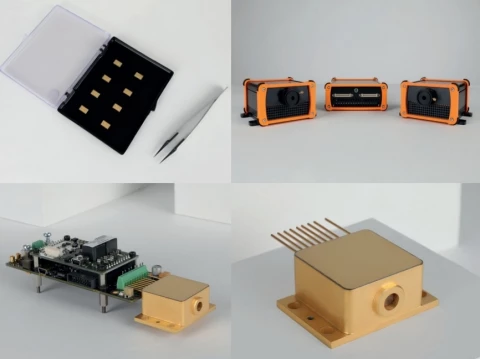PowerMir 4.0µm High Power Pulsed Quantum Cascade Laser 500mW
For pricing, technical or any other questions please contact the supplier
- No registration required
- No markups, no fees
- Direct contact with supplier
-
Ships from:
United States
-
Sold by:
-
On FindLight:
since 2014
Description
Introducing the PowerMir 4.0µm High Power Pulsed Quantum Cascade Laser, a cutting-edge solution designed to meet the demands of industrial and research applications. This advanced laser system, proudly manufactured in France by mirSense, offers unparalleled performance, reliability, and versatility.
At the heart of the PowerMir series lies a high-power pulsed Fabry Perot Quantum Cascade Laser (QCL), emitting precise wavelengths around 4 microns. Leveraging proprietary technology, these lasers deliver exceptional power and wall-plug efficiency, making them ideal for a wide range of applications.
One of the key advantages of the PowerMir lasers is their ITAR-free status, ensuring hassle-free procurement and deployment for customers worldwide. Whether you're in the OEM, industrial, medical, or scientific sector, you can rely on PowerMir lasers to deliver consistent, high-quality results.
The PowerMir product line offers various configurations to suit your specific needs. Choose from plug-and-play benchtop turnkey systems for lab development, OEM modules for integration into existing products, or standalone laser packages for standalone applications.
Featuring a quasi-CW operating mode, these lasers optimize wall-plug efficiency while minimizing thermal dissipation, resulting in enhanced performance and longevity. Additionally, the circular beam option reduces beam shaping efforts, streamlining your workflow and increasing productivity.
With reproducible specs manufacturing and a robust design, PowerMir lasers ensure consistent performance even in demanding environments. Backed by mirSense's commitment to quality and customer satisfaction, the PowerMir series sets the standard for high-power pulsed quantum cascade lasers
PowerMir 4.0µm High Power Pulsed Quantum Cascade Laser 500mW
Specifications |
|
|---|---|
| Output Power (avg): | 0.5 W |
| Wavelength: | 4 um |
| Pulse Duration: | Not Specified |
| Tuning Range Around Center Wavelength: | Not Applicable |
| Mode Of Operation: | Quasi-CW, high duty cycled pulsed |
| Pulse Frequency: | > 500 kHz |
| Divergence For The Lasers With Standard Beam: | < 6 mrad (horizontal) / < 4 mrad (vertical) |
| Divergence For The Lasers With Circular Beam Option: | < 3,5 mrad |
| Elliptical Ratio Of The Circular Beam: | <1.2 |
| Far Field Beam Quality: | TM00 Gaussian beam |
| Output Beam Dimension For The Standard Beam Option (window Output): | Typically 3 mm (vertical) x 2 mm (horizontal) |
| Output Beam Dimension For The Circular Beam Option (window Output): | Typically < 3mm |
| Polarization: | Linear vertically polarized (>98%) |
| Reliability: | > 3500 h |
| Input Power: | 24V DC (an AC/DC power transformer is supplied) |
| Dimension: | laser head 20cm x 15cm x 6cm / driver: 25cmx15cmx6cm |
| Weigh: | 925 g |
| Operational Temperature Range: | 10-30 °C |
| Laser Head Cooling: | Air cooled |
Features
- ITAR free MIR high-power quantum cascade laser systems
- Quasi-CW operating mode for increased wall-plug efficiency and reduced thermal
- dissipation
- Reproducible specs manufacturing for series productions.
- Circular beam option to reduce beam shaping efforts
Applications
- Lab development purposes
- Integration into products
- Standalone laser purchase
Frequently Asked Questions
The PowerMir laser operates in a quasi-CW (Continuous Wave) mode, with high duty cycled pulsed performance.
The maximum power output of the PowerMir laser varies depending on the specific model, with options ranging from greater than 1W to less than 100mW or less than 500mW, as indicated in the product specifications.
The central wavelength of the PowerMir laser is approximately 4 µm, with a tolerance of +/- 0.1 µm.
Yes, the PowerMir laser offers pulse frequencies greater than 500 kHz, making it suitable for high-frequency pulse applications.
The divergence of the PowerMir laser beam is specified as less than 6 mrad (horizontal) and less than 4 mrad (vertical) for lasers with standard beam options.
The PowerMir laser is available in three main system configurations: HHL-packaged lasers, OEM modules with a PCB driver, and plug-and-play benchtop turnkey systems. Each configuration offers unique features and benefits tailored to different application needs.
Yes, the PowerMir laser supports external modulation, allowing users to modulate the laser power using external TTL signals or Windows software.
The PowerMir laser is designed to operate within a temperature range of -20°C to +30°C at the base plate, ensuring reliable performance in various environmental conditions.
Yes, the PowerMir laser incorporates built-in safety features, including laser safety interlocks, temperature control mechanisms, and laser driver firmware safeguards, to ensure safe and reliable operation.
Yes, multiple PowerMir lasers can be synchronized and controlled simultaneously using Modbus communications over RS485, allowing for coordinated operation in complex laser systems.

